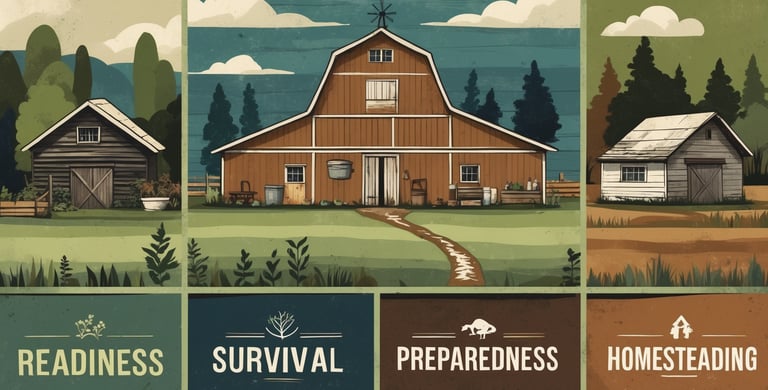Foundations of Readiness, Survival, Preparedness, and Homesteading
Emergency Preparedness Foundations: An Introduction to the Readiness REALM
4FORTITUDER - READINESS, SURVIVAL, PREPAREDNESS, HOMESTEADING


Foundations of Readiness, Survival, Preparedness, and Homesteading
Building Resilient Foundations for a Sustainable Future
"In the midst of chaos, there is also opportunity."
– Sun Tzu
In an unpredictable world where uncertainties loom large, the principles of Readiness, Survival, Preparedness, and Homesteading emerge as essential pillars for building resilience and sustainability. These interconnected realms offer practical strategies and profound insights into safeguarding oneself and fostering a self-sufficient lifestyle. For those committed to the 4FORTITUDE Model, mastering these areas not only ensures personal safety and well-being but also cultivates independence and a harmonious relationship with nature.
This comprehensive guide delves deep into Readiness, Survival, Preparedness, and Homesteading, exploring their interrelations and providing actionable steps to integrate these practices into everyday life. Through metaphors, analogies, and illustrative parables, we will navigate the practical and philosophical dimensions of these domains, empowering you to build a resilient and sustainable future.
Understanding the Foundations
Defining Key Concepts
To embark on this journey, it is essential to clearly define the four pillars that underpin a resilient and self-sufficient lifestyle:
Readiness: The state of being fully prepared to face emergencies or unexpected situations. It involves having the necessary knowledge, skills, and resources at hand.
Survival: The ability to sustain life in adverse conditions, utilizing available resources effectively to overcome challenges.
Preparedness: The proactive measures taken to anticipate and mitigate potential threats, ensuring readiness for various scenarios.
Homesteading: The practice of self-sufficiency through sustainable living, including food production, resource management, and independence from external systems.
The Interconnectedness
Imagine these four pillars as the foundation of a sturdy fortress. Readiness acts as the watchtower, always alert to potential threats. Survival is the core strength, enabling resilience against assaults. Preparedness is the strategic planning and resource allocation that ensure the fortress can withstand sieges. Homesteading represents the self-sustaining infrastructure, providing the necessary resources to thrive independently. Together, they create a formidable structure that safeguards well-being and fosters independence.
Readiness: The State of Constant Vigilance
The Role of Readiness
Readiness is the proactive mindset that ensures you are always prepared for unforeseen events. It encompasses mental, physical, and logistical preparedness, enabling swift and effective responses to emergencies.
Contrarian View: While some may view readiness as an overemphasis on fear and uncertainty, true readiness is about empowerment and confidence in one's ability to handle challenges.
Cultivating Readiness
Enhancing readiness involves developing a comprehensive plan and maintaining the necessary resources:
Education and Training: Acquire knowledge in first aid, emergency response, and basic survival skills.
Resource Inventory: Maintain a well-stocked emergency kit with essential supplies such as food, water, medical supplies, and tools.
Communication Plans: Establish clear communication protocols with family or community members during emergencies.
Regular Drills: Conduct routine drills to practice emergency procedures and ensure everyone knows their roles.
Survival: Thriving in Adverse Conditions
The Essence of Survival
Survival is the ability to sustain life in challenging environments using available resources. It involves strategic thinking, resourcefulness, and adaptability to overcome obstacles.
Metaphor: Survival is the heartbeat of resilience, pulsating with the determination to thrive against all odds.
Core Survival Skills
Developing essential survival skills is crucial for navigating adverse conditions:
Shelter Building: Learn how to construct and maintain shelters using natural and available materials.
Fire Making: Master various fire-starting techniques to provide warmth, cook food, and signal for help.
Water Purification: Understand methods to source and purify water to ensure safe drinking supplies.
Foraging and Hunting: Gain knowledge of edible plants and hunting techniques to secure food sources.
Preparedness: Anticipating and Mitigating Threats
The Role of Preparedness
Preparedness is the proactive stance taken to anticipate and mitigate potential threats before they escalate into crises. It involves strategic planning, risk assessment, and the implementation of preventive measures.
Analogy: Preparedness is like planting seeds for future growth; it requires foresight and consistent effort to reap the benefits when needed.
Developing a Preparedness Plan
Creating a robust preparedness plan involves several key steps:
Risk Assessment: Identify potential threats specific to your region and lifestyle.
Resource Allocation: Ensure critical supplies are accessible and well-maintained.
Training and Education: Engage in regular training sessions to enhance preparedness skills.
Community Engagement: Foster relationships within your community to build a support network.
Homesteading: Cultivating Self-Sufficiency
The Essence of Homesteading
Homesteading is the practice of self-sufficiency through sustainable living, encompassing food production, resource management, and independence from external systems. It embodies resilience, adaptability, and a deep connection to the land.
Metaphor: Homesteading is the art of weaving one's life into the fabric of nature, creating a sustainable and harmonious existence.
Core Elements of Homesteading
Developing a homesteading lifestyle involves mastering several key areas:
Gardening and Agriculture: Cultivate a variety of crops and maintain a sustainable garden.
Animal Husbandry: Raise livestock such as chickens, goats, or bees.
Preservation Techniques: Learn methods such as canning, drying, and fermenting.
Energy Independence: Implement renewable energy sources like solar panels or wind turbines.
Water Management: Establish systems for rainwater harvesting and irrigation.
VII. Integrating the Elements for a Resilient and Sustainable Lifestyle
Creating a Synergistic Framework
Readiness and Preparedness: Form the proactive foundation.
Survival Skills: Provide the practical abilities and mental resilience.
Homesteading: Establishes a self-sufficient lifestyle.
Continuous Learning and Adaptation: Ensures long-term resilience.
Conclusion
"The best preparation for tomorrow is doing your best today." – H. Jackson Brown Jr.
Embrace this comprehensive framework, take intentional steps toward enhancing your readiness and preparedness, develop essential survival skills, and embark on the fulfilling journey of homesteading. Through this holistic approach, you build a life marked by resilience, sustainability, and enduring fortitude, ensuring that you and those around you thrive in the face of any challenge.
